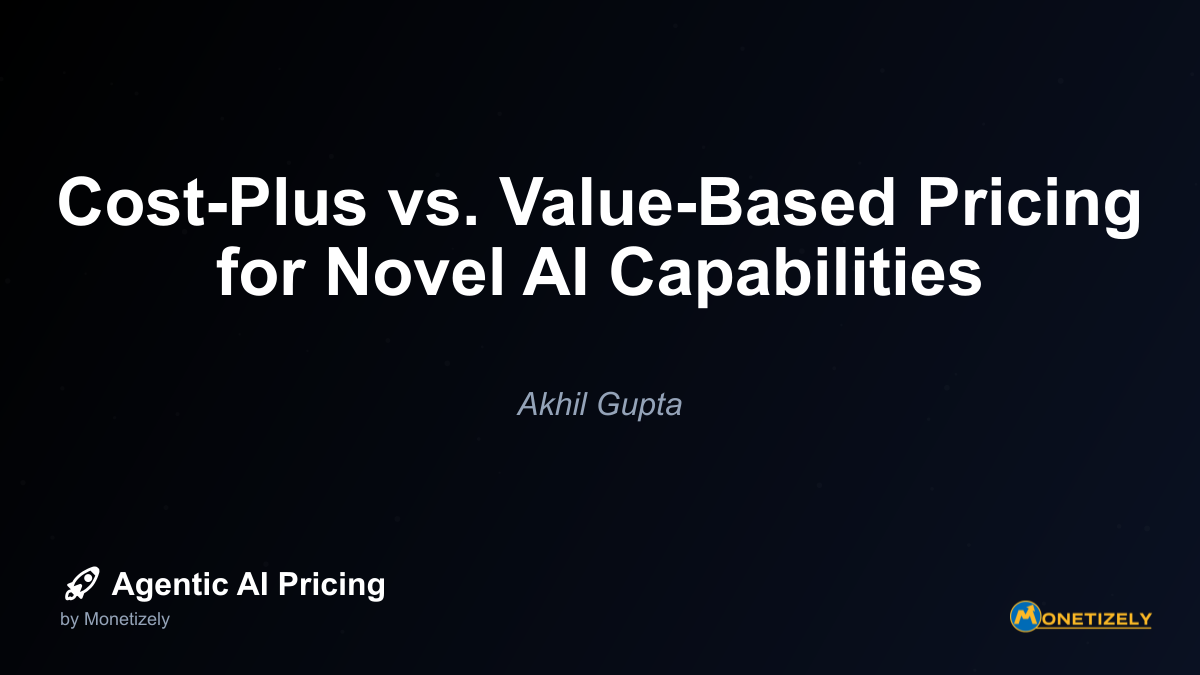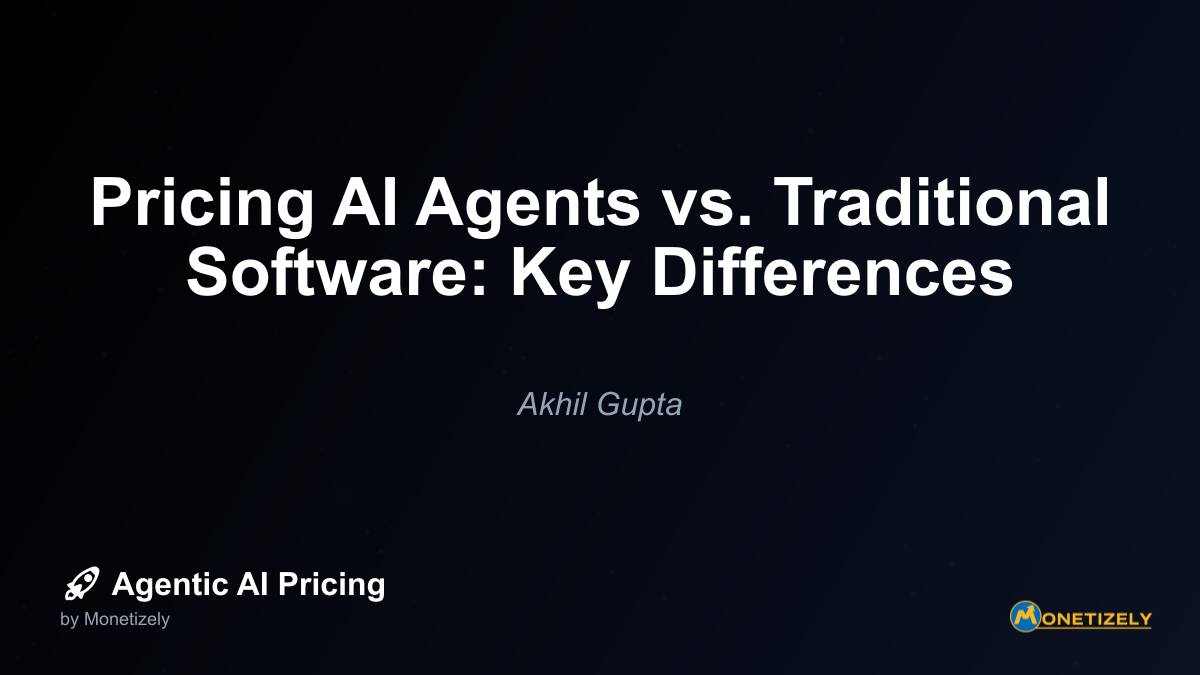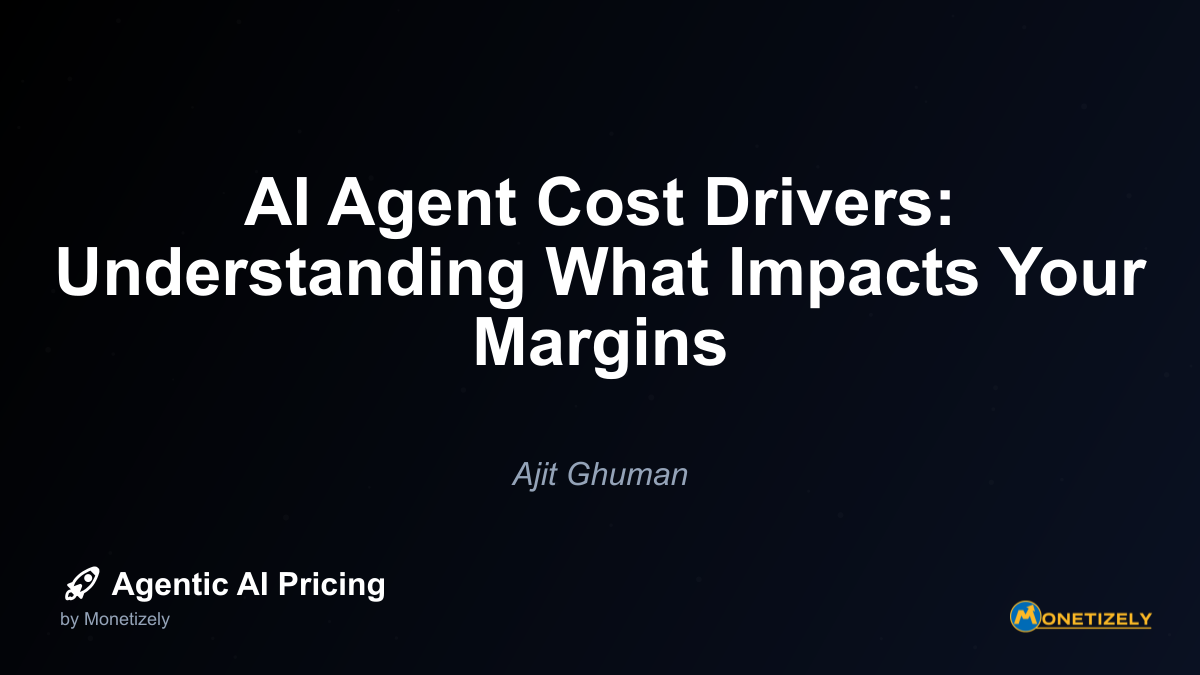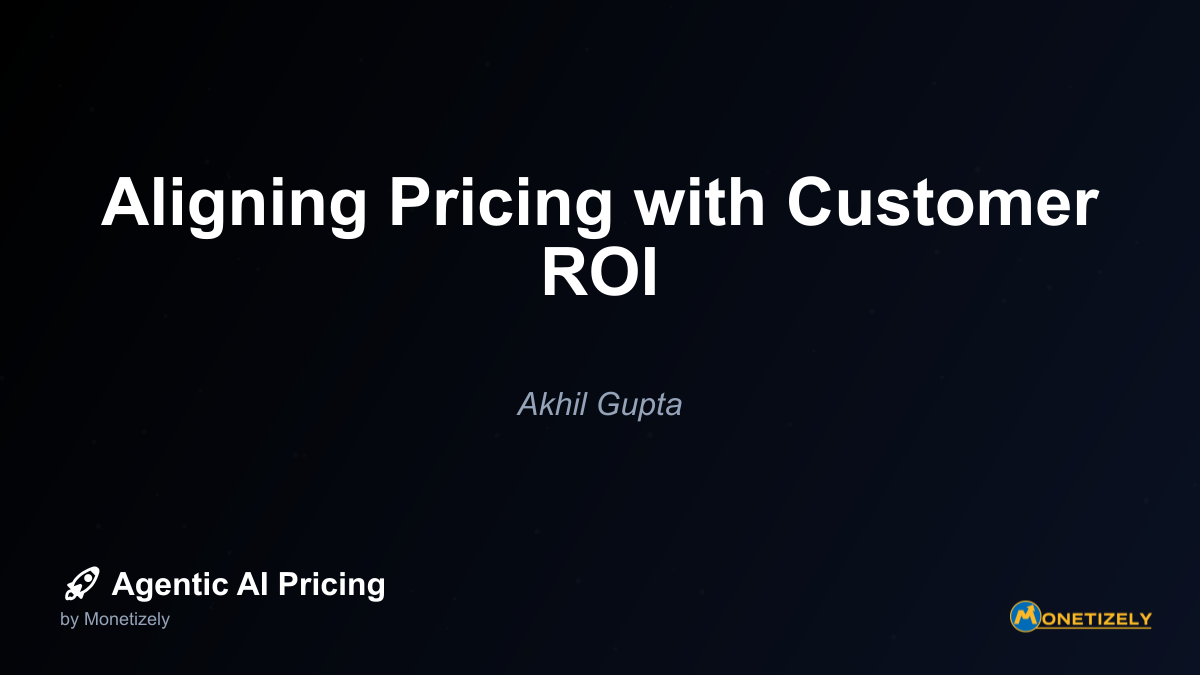· Akhil Gupta · AI Pricing Fundamentals · 6 min read
Cost-Plus vs. Value-Based Pricing for Novel AI Capabilities
AI and SaaS Pricing Masterclass
Learn the art of strategic pricing directly from industry experts. Our comprehensive course provides frameworks and methodologies for optimizing your pricing strategy in the evolving AI landscape. Earn a professional certification that can be imported directly to your LinkedIn profile.

Case Study 2: Computer Vision Startup
A computer vision startup initially employed value-based pricing for their novel object recognition system, focusing on the labor cost savings their technology provided to manufacturing clients. Their pricing formula:
Annual Price = (Labor Hours Saved × Average Labor Cost) × 30% Value CaptureWhile this approach maximized revenue from early adopters, they encountered scaling challenges as they moved beyond innovators to the early majority. The company ultimately implemented a hybrid model that ensured cost recovery while still capturing value differentially across customer segments.
How to Determine the Right Approach for Your Novel AI Capability
Choosing between cost-plus and value-based pricing requires a structured evaluation process:
1. Value Discovery Assessment
Begin by thoroughly investigating the value your AI capability delivers:
- Customer Interviews: Conduct in-depth interviews with potential users
- Economic Impact Analysis: Quantify potential cost savings, revenue increases, or risk reductions
- Alternative Solution Comparison: Evaluate how your capability compares to manual processes or competing technologies
- Value Perception Testing: Assess how different customer segments perceive the value proposition
2. Cost Structure Analysis
Thoroughly analyze your cost structure to understand baseline requirements:
- Development Cost Allocation: Determine how R&D costs should be allocated across the product lifecycle
- Marginal Cost Evaluation: Assess the incremental cost of serving additional customers
- Scale Economics: Project how costs will change as adoption increases
- Sustainability Requirements: Calculate the pricing needed for long-term sustainability
3. Market Readiness Evaluation
Assess market conditions that influence pricing strategy selection:
- Education Requirements: Determine how much customer education is needed
- Adoption Barriers: Identify obstacles to customer adoption
- Competitive Dynamics: Analyze existing and potential competitive threats
- Market Timing: Consider where the market sits in the adoption curve
4. Implementation Capability Assessment
Evaluate your organization’s ability to execute different pricing approaches:
- Value Communication Capabilities: Assess sales team’s ability to articulate value
- Research Resources: Evaluate resources available for value quantification
- Pricing Technology: Determine if you have tools to implement complex pricing models
- Change Management Capacity: Consider organizational readiness for pricing approach changes
Implementing a Hybrid Approach for Novel AI Capabilities
For many organizations, the optimal strategy for pricing novel AI capabilities involves a hybrid approach that evolves over time:
Phase 1: Cost-Plus Foundation with Value Elements
In early market stages, establish a pricing floor based on costs while incorporating value elements:
- Base Price: Calculated using cost-plus to ensure sustainability
- Value Metrics: Identify key value drivers to monitor
- Customer Segmentation: Begin segmenting customers by value perception
- Value Documentation: Start collecting value realization data
Phase 2: Value-Informed Transitional Pricing
As value understanding improves, shift toward more value-oriented approaches:
- Segment-Specific Pricing: Develop differentiated pricing by customer segment
- Value-Based Packaging: Create packages aligned with value delivery
- ROI Calculators: Develop tools demonstrating economic impact
- Success Stories: Build case studies documenting realized value
Phase 3: Mature Value-Based Pricing
As the market matures, transition to sophisticated value-based approaches:
- Outcome-Based Models: Link pricing directly to customer outcomes
- Value-Based Segmentation: Refine segments based on value realization
- Dynamic Value Pricing: Adjust pricing based on demonstrated value
- Value Guarantee Programs: Offer guarantees tied to value delivery
Communicating Price for Novel AI Capabilities
Regardless of which pricing methodology you select, effective price communication is essential for novel AI capabilities:
Value Articulation Strategies
Develop clear messaging that articulates value in customer-relevant terms:
- Problem-Centric Framing: Focus on the specific problems your AI solves
- Outcome Visualization: Help customers envision the post-implementation state
- Comparative Economics: Show economic advantage versus alternatives
- Risk Reduction Emphasis: Highlight how your solution reduces uncertainty
Addressing Novel Technology Concerns
Proactively address concerns specific to innovative AI capabilities:
- Implementation Clarity: Provide transparent onboarding processes
- Integration Assurance: Demonstrate compatibility with existing systems
- Performance Guarantees: Offer guarantees around key performance metrics
- Adoption Support: Include training and change management resources
The Evolution of AI Pricing Models
The pricing of novel AI capabilities represents an evolving discipline that continues to mature:
From Features to Outcomes
The industry is witnessing a gradual shift from feature-based pricing to outcome-based models:
- Usage-Based Models: Charging based on consumption metrics
- Performance-Based Pricing: Linking price to achieved performance levels
- Outcome-Sharing Arrangements: Revenue or savings sharing models
- Risk-Reward Structures: Models where vendors share both upside and downside
The Role of Experimentation
For truly novel AI capabilities, pricing often requires systematic experimentation:
- A/B Testing: Testing different pricing approaches across customer segments
- Limited Releases: Using controlled releases to gather pricing intelligence
- Beta Pricing Programs: Special pricing for early adopters with feedback requirements
- Dynamic Adjustment Mechanisms: Building in structures to evolve pricing as learning occurs
Measuring Success in AI Capability Pricing
Evaluating the effectiveness of your pricing approach requires looking beyond revenue metrics:
Key Performance Indicators
Monitor these metrics to assess pricing strategy effectiveness:
- Customer Acquisition Cost (CAC): Cost to acquire new customers
- Customer Lifetime Value (CLV): Total value generated over customer relationship
- Value Realization Rate: Percentage of promised value actually delivered
- Expansion Revenue: Additional revenue from existing customers
- Price Realization: Actual revenue versus list price
- Win/Loss Analysis: Reasons for winning or losing deals
Continuous Pricing Optimization
Implement processes for ongoing pricing refinement:
- Value Tracking Systems: Monitoring actual value delivered to customers
- Regular Pricing Reviews: Scheduled assessments of pricing effectiveness
- Customer Feedback Loops: Structured processes to gather pricing feedback
- Competitive Intelligence: Ongoing monitoring of market pricing developments
Ethical Considerations in AI Capability Pricing
The pricing of novel AI capabilities raises important ethical considerations:
Access and Equity Issues
Consider how pricing impacts who can benefit from your innovation:
- Digital Divide Implications: How pricing affects access across different groups
- Critical Application Considerations: Special pricing for socially valuable applications
- Educational Access: Programs for academic and research communities
- Developing Market Strategies: Approaches for economically diverse markets
Transparency Requirements
Novel technologies demand heightened transparency in pricing:
- Clear Value Communication: Honest articulation of capabilities and limitations
- Pricing Logic Disclosure: Appropriate transparency around how prices are determined
- Performance Guarantees: Clear commitments regarding capability performance
- Data Usage Clarity: Transparency about how customer data influences pricing
Conclusion: Balancing Art and Science in AI Pricing
Pricing novel AI capabilities ultimately requires balancing analytical rigor with strategic judgment. While cost-plus approaches offer simplicity and predictability, they often leave significant value uncaptured. Conversely, value-based pricing maximizes revenue potential but requires sophisticated implementation capabilities and market readiness.
For most organizations introducing innovative AI features, the optimal approach involves a thoughtful hybrid strategy that evolves as market understanding matures. Begin with a cost-informed foundation that ensures sustainability, while systematically building the capabilities needed for value-based approaches. As market education progresses and value quantification improves, gradually shift toward more sophisticated value-capture mechanisms.
Remember that pricing strategy for novel AI capabilities isn’t a one-time decision but rather an ongoing process of refinement. By establishing robust feedback loops and measurement systems, you can continuously optimize your approach as market conditions evolve and customer value perceptions mature.
The organizations that master this balance—capturing fair value while driving adoption—will ultimately define the winners in the emerging AI capability landscape.
Co-Founder & COO
Akhil is an Engineering leader with over 16+ years of experience in building, managing and scaling web-scale, high throughput enterprise applications and teams. He has worked with and led technology teams at FabAlley, BuildSupply and Healthians. He is a graduate from Delhi College of Engineering and UC Berkeley certified CTO.
Pricing Strategy Audit
Let our experts analyze your current pricing strategy and identify opportunities for improvement. Our data-driven assessment will help you unlock untapped revenue potential and optimize your AI pricing approach.




